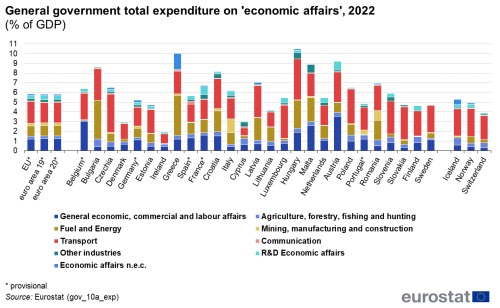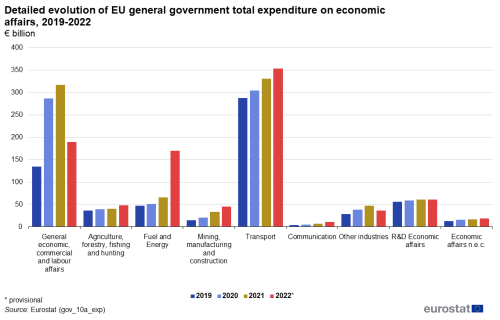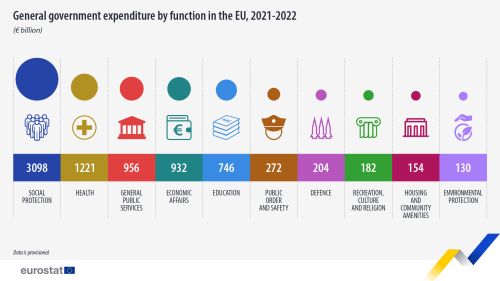Government expenditure on economic affairs
Data extracted on 29 February 2024
Planned article update: February 2025
Highlights
General government expenditure in the EU on 'economic affairs' amounted to €932 billion or 5.9 % of GDP in 2022.

This article analyses data on general government expenditure on 'economic affairs' (according to the Classification of the Functions of Government - COFOG). It is part of a set of statistical articles based on general government expenditure by function.
Eurostat collects data on general government expenditure by economic function according to the international Classification of the Functions of Government (COFOG) in the framework of the European System of National Accounts (ESA 2010).
Full article
Expenditure on 'economic affairs'
Government expenditure on 'economic affairs' at the level of the reporting countries exhibits considerable variability over time as recorded amounts may be influenced by operations of an extraordinary nature, such as disposal of non-financial non-produced assets (recorded as negative expenditure) and capital injections recorded as capital transfers. Such capital injections are notably benefitting financial institutions and public corporations. Other extraordinary capital transfers comprise guarantee calls. Furthermore, the majority of subsidies granted to producers are recorded in this division.
In 2022 in the EU, total expenditure of general government on 'economic affairs' represented 5.9 % of GDP, a decrease compared with 2021 (-0.4 percentage points). The decrease in the ratio compared with the previous year (6.3 %) was mainly a consequence of increases in GDP, while growth in 'economic affairs' expenditure was still observed. For the years 2020 and 2021, this division was highly impacted by the COVID-19 pandemic as governments introduced measures to mitigate its effects, most notably by furlough schemes recorded as subsidies to the employer, other subsidies introduced in the context of the COVID-19 pandemic and capital injections recorded as capital transfers. In 2022, this division was still influenced by the government measures to mitigate the impact of the COVID-19 pandemic, although to a lesser extent than in 2020 and 2021. However, government measures to mitigate the impact of increasing energy prices strongly influenced the level of expenditure in this division in 2022. Besides variability over time, there are also considerable variations at the level of Member States.
Within the division 'economic affairs', at the level of the EU in 2022, the highest ratio to GDP represented expenditure related to 'transport' (2.2 % of GDP), followed by expenditure on 'general economic, commercial and labour affairs' (1.2 % of GDP), and by 'fuel and energy' (1.1 % of GDP). Research and development related to economic affairs accounted for 0.4 % of GDP. 'Agriculture, forestry, fishing and hunting' and 'mining, manufacturing and construction' both made up 0.3 % of GDP. Economic affairs related to 'other industries' made up 0.2 % of GDP. Expenditure not elsewhere classified (n.e.c.) and 'communication' amounted both for 0.1 % of GDP.
In the EU, a large part of expenditure on agriculture, forestry and fisheries falls within the competency of the EU. As a consequence, expenditure of national governments of EU Member States in this group tends to be smaller in comparison with EFTA and other countries. Iceland recorded 0.7 % of GDP in this group.
Capital injections into financial institutions recorded as capital transfers explain the relatively high figures for some countries over the time period. Such expenditure is recorded in COFOG group 'general economic, commercial and labour affairs'. In 2020 and 2021 also capital transfers, including investments grants, in relation to 'mining, manufacturing and construction' and 'transport' were at a high level. In 2021 and 2022, there was an important increase related to 'fuel and energy', linked to support measures in relation to the increases in energy prices (subsidies and capital transfers).
In 2022, government expenditure reported by countries on 'economic affairs' ranged between 2.0 % of GDP and 10.5 % of GDP

For 2022, Hungary reported the highest amount for 'economic affairs' expressed as ratio to GDP (10.5 %), followed by Greece (10.0 %), Austria (9.2 %), Malta (8.9 %), Bulgaria (8.6 %) and Croatia (8.1 %). The lowest amounts of government expenditure were found in Ireland (2.0 %), Denmark (2.9 %) and Cyprus (3.0 %).
The importance of the 'economic affairs' division is highly dependent on the amount of subsidies given to public or private transportation companies. Expenditure of transport companies (including those responsible for transport infrastructure), that are classified within the general government sector, are even more important contributors to this functional group. In particular capital investments (gross capital formation) is dominant in this group. In 2022, the highest expenditure to GDP ratios for 'transport' were recorded in Hungary (4.2 %), Czechia (3.9 %), Poland (3.5 %), Slovenia, Luxembourg and Slovakia (all 3.4 %). By contrast, the lowest level of expenditure in 'transport' in relation to GDP was observed in Cyprus (0.8 %) and in Ireland (1.0 %).
In 2022, the highest amounts recorded for 'general economic, commercial and labour affairs' were for Austria (3.5 % of GDP), Belgium (3.1 % of GDP) and Malta (2.6 % of GDP). For the years 2020 and 2021, and to a lower extent in 2022, in this functional group the labour market measures to mitigate the effects of the COVID-19 pandemic (e.g. furlough schemes) were recorded as well as other subsidies granted irrespective of industry concerned; e.g. in 2022, general subsidies assisting businesses using energy as an input to their productions.
Slight annual increase in 2022 for expenditure on 'economic affairs' after the strong increases in 2020 and 2021
Overall, EU general government expenditure grew from €7 516 billion in 2021 to €7 894 billion in 2022, with increases observed across all functions of expenditure. In 2022, expenditure on 'economic affairs' stood at €932 billion increased slightly compared with 2021 (€917 billion), remaining high in comparison with pre-COVID-19 pandemic level. In 2020 and in 2021, the relative increases observed, compared with 2019, were mostly due to government measures taken to counterbalance the negative economic effects of the COVID-19 pandemic, for example by providing subsidies to businesses affected by the pandemic, capital injections (e.g. for transport companies) and furlough schemes (insofar as these are recorded as subsidies, that is considered to primarily provide general support to the labour market; some furlough schemes are recorded in social protection if they are deemed to primarily support the affected employees). In 2022, this division was still influenced by the government measures to mitigate the impact of the COVID-19 pandemic, although to a lesser extent than in 2020 and 2021. However, government measures to mitigate the impact of increasing energy prices strongly influenced the level of expenditure in this division in 2022.
At the level of the EU, expenditure on 'economic affairs' increased by €15 billion between 2021 and 2022 (€932 billion in 2022 and €917 billion in 2021). The share of 'economic affairs' expenditure in total expenditure decreased from 12.2 % in 2021 to 11.8 % in 2022. Despite the 2022 decrease, the share of 'economic affairs' expenditure in total expenditure continued to remain relatively high, after reaching in 2021 the highest share since 1995 (1995: 13.6 % of total expenditure due to a one-off event in Germany).

Looking at the detail of functions within 'economic affairs', at EU level, the strongest increases between 2021 and 2022 can be observed in the groups 'fuel and energy' (€170 billion in 2022 compared with €65 billion in 2021) and 'transport' (€353 billion in 2022 compared with €331 billion in 2021). The evolution in these detailed functions is strongly influenced by support measures to mitigate the impact of high energy prices. The strongest decreases are observed in 'general economic, commercial and labour affairs' (€189 billion in 2022 compared with €317 billion in 2021) and reflect the lower impact of measures to mitigate the impact of the COVID-19 pandemic in 2022, even if the level remains above the year 2019.
Subsidies are the most important form of expenditure within 'economic affairs'
In 2022, at the level of the EU, subsidies were the most important part of expenditure on economic affairs, with a share of 32 %, followed by capital investments (20 %), capital transfers (16 %), intermediate consumption (15 %) and compensation of employees (wages, salaries and employers' social contributions) (11 %).
Source data for tables and graphs
The detailed tables ![]() are available here.
are available here.
Data sources and availability
Reporting of data to Eurostat
Annual government finance statistics (GFS) data are collected by Eurostat on the basis of the European System of Accounts (ESA 2010) transmission programme. Member States are requested to transmit, among other tables, table 1100, 'Expenditure of general government by function' twelve months after the end of the reference period. Table 1100 provides information about expenditure of the general government sector divided into main COFOG functions and ESA 2010 categories. The transmission of the COFOG I level breakdown (divisions) is compulsory for the years 1995 onwards, whereas information on the COFOG II level (COFOG groups) is provided on a compulsory basis for the general government sector from the reference years 2001 onwards. The main reference year used in this publication is 2022 as the latest year available at EU level.
Data was extracted on 29 February 2024.
Provisional data
While a significant effort was undertaken to harmonise the recording of government measures to alleviate the impact of increasing energy prices, a full harmonisation of data for the reference year 2022 was not yet achieved.
Data for the EU and euro area aggregates (2022), Belgium (2022), Germany (2020-2022), Spain (2022), France (2021-2022) and Portugal (2022) is provisional.
Definition of general government and its subsectors
The data relate to the general government sector of the economy, as defined in ESA 2010, paragraph 2.111: 'The general government sector (S.13) consists of institutional units which are non-market producers whose output is intended for individual and collective consumption, and are financed by compulsory payments made by units belonging to other sectors, and institutional units principally engaged in the redistribution of national income and wealth’.
Classification of functional expenditure of government
The Classification of the Functions of Government (COFOG) classifies government expenditure into ten main categories (divisions known as the 'COFOG I level' breakdown): general public services; defence; public order and safety; economic affairs; environmental protection; housing and community affairs; health; recreation, culture and religion; education; social protection. These divisions are further broken down into 'groups' (COFOG II level).
For 'economic affairs', the groups are
- 'general economic, commercial and labour affairs',
- 'agriculture, forestry, fishing and hunting',
- 'fuel and energy',
- 'mining, manufacturing and construction',
- 'transport',
- 'communication',
- 'other industries',
- 'R&D economic affairs',
- 'economic affairs n.e.c.'
Further information is available in the Eurostat Manual on sources and methods for the compilation of COFOG Statistics.
Satellite accounts
Administrative expenditure data is additionally collected in so-called satellite accounts. In general, the amount of expenditure recorded in satellite accounts is expected to exceed the expenditure recorded under the respective COFOG division. More details on the comparability of COFOG data with satellite accounts data can be found in the COFOG manual.
Definition of general government total expenditure
Government total expenditure is defined in ESA 2010, paragraph 8.100 by using as reference a list of ESA 2010 categories. More detail is provided in the overview article on Government expenditure by function – COFOG.
Gross Domestic Product
Throughout this publication, nominal GDP, i.e. GDP at current prices is used.
Time of recording & symbols used
In the ESA 2010 system, recording is on an accrual basis, that is, when ‘economic value is created, transformed or extinguished, or when claims and obligations arise, are transformed or are cancelled.'
":" not available
"pp" percentage points
More data and information
For more country-specific notes, e.g. on missing data, please refer to the metadata published on Eurobase. The authors can be contacted at ESTAT-GFS@ec.europa.eu
Context
In the framework of the European System of National Accounts (ESA 2010), Eurostat collects data on general government expenditure by economic function according to the international Classification of the Functions of Government (COFOG) – see methodological note.
Direct access to
- Government expenditure by function - online publication
- Government expenditure by function – COFOG - overview article
- Government statistics (t_gov)
- Annual government finance statistics (t_gov_10a)
- Government statistics (gov)
- Government finance statistics (EDP and ESA2010) (gov_gfs10)
- Annual government finance statistics (gov_10a)
- Government revenue, expenditure and main aggregates (gov_10a_main)
- General government expenditure by function (COFOG) (gov_10a_exp)
- Main national accounts tax aggregates (gov_10a_tax_ag)
- Annual government finance statistics (gov_10a)
- Government finance statistics (EDP and ESA2010) (gov_gfs10)
- Government revenue, expenditure and main aggregates (ESMS metadata file — gov_10a_main_esms)
- General government expenditure by function (COFOG) (ESMS metadata file — gov_10a_exp_esms)
- Manual on government deficit and debt — implementation of ESA 2010 — 2022 edition
